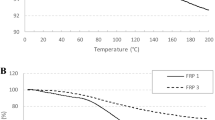Abstract
A small-scale loading frame was used to apply tensile and compressive stresses to glass vinyl ester and glass polyester laminates in a cone calorimeter under a heat flux of 75kW m−2. It was found, for the first time, that stress has a small but significant effect on the fire reaction properties. Increasing tensile stress increased heat release rate and smoke production, while shortening the time-to-ignition. Compressive stress had the reverse effect. This was attributed to the fact that tensile stress promotes the formation of matrix microcracks, facilitating the evolution of flammable volatiles. This hypothesis is further supported by the observation that stress has the greatest effect on the early heat and smoke release peaks, with a lower effect on the final ‘run-out’ values.
Stress rupture (time-to-failure) curves were produced for tension and compression. In tension, the behaviour was fibre dominated, with times-to-failure being roughly ten times those in compression. Compressive failure involved resin dominated local fibre kinking, initiated near to the rear face of the specimen. The failure time was determined by a significant proportion of the specimen reaching its glass transition temperature.
Access this chapter
Tax calculation will be finalised at checkout
Purchases are for personal use only
Preview
Unable to display preview. Download preview PDF.
Similar content being viewed by others
References
Mouritz AP, Gibson AG. Fire Properties of Polymer Matrix Composites. Springer, Dordrecht, 2006.
Lyon RE, Demario J, Walters RN, Crowley S. Flammability of glass fibre-reinforced polymer composites. In: Proceedings of the 4th International Conference on Composites in Fire, Newcastle upon Tyne, England, 2005.
Mouritz AP, Mathys Z, Gibson AG. Heat release of polymer composites in fire. Composites, Part A 2006; 37:1040–1054.
Koo JH, Muskop F, Venumbaka R, Van Dine R, Spencer B, Sorathia U. Flammability properties of polymer composites for marine applications. In: Proceedings of the 32nd International SAMPE Technical Conference, 5–9 November 2000.
Brown JR, Mathys Z, Reinforcement and matrix effects on the combustion properties of glass reinforced polymer composites. Composites, Part A 1997; 28(7):675–681.
Beeson HD, Hshieh F-Y. Flammability testing of flame-retarded epoxy composites and phenolic composites. Fire and Materials 1997; 21(1):41–49.
Lyon RE. Plastics and rubber. In: C.A. Harper, editor. Chapter 3 in Handbook of Building Materials for Fire Protection. McGraw-Hill, New York, 2004.
Mouritz AP, Mathys Z. Post-fire mechanical properties of marine polymer composites. Composite Structures 1999; 47: 643–653.
Mouritz AP, Mathys Z. Post-fire mechanical properties of glass-reinforced polyester composites. Composites Science and Technology 2001; 61(4):475–490.
Gibson AG, Wright PNH, Wu Y-S, Mouritz AP, Mathys Z, Gardiner CP. Modelling residual mechanical properties of polymer composites after fire. Plastics, Rubber and Composites 2003; 32(2):81–90.
Gibson AG, Wright PNH, Wu Y-S, Mouritz AP, Mathys Z, Gardiner CP. The Integrity of polymer composites during and after fire. Journal of Composite Materials 2004; 38(15):1283–1307.
Bausano J, Boyd S, Lesko J, Case S. Composite lifetime during combined compressive loading and one-sided simulated fire exposure. Composites, Part A: 2005; 37(7):1092–1100.
Easby RC, Feih S, Konstantis C, La Delfa G, Urso Miano V, Elmughrabi A, Mouritz AP, Gibson AG. Failure model for phenolic and polyester pultrusions under load in fire. Plastics, Rubber and Composites 2007; 36(9):379–388.
Feih S, Mathys Z, Mathys G, Gibson AG, Robinson M, Mouritz AP. Influence of water content on failure of phenolic composites in fire. Polymer Degradation and Stability 2008; 93(2):376–382.
Gibson AG, Wright PNH, Wu Y-S, Evans JT. Laminate theory analysis of composites under load in fire. Journal of Composite Materials 2006; 40(7):639–658.
Feih S, Mathys Z, Gibson AG, Mouritz AP. Modelling the compression strength of polymer laminates in fire. Composites, Part A 2007; 38(11):2354–2365.
Feih S, Mouritz AP, Mathys Z, Gibson AG. Tensile strength modelling of glass fiber-polymer composites in fire. Journal of Composite Materials 2007; 41(19):2387–2410.
Feih S, Mathys Z, Gibson AG, Mouritz AP. Modelling the tension and compression strengths of polymer laminates in fire. Composites Science and Technology 2007; 67(3–4):551–564.
Babrauskas V. Development of the Cone Calorimeter: A Bench Scale Heat Release Rate Apparatus Based on Oxygen Consumption (NBSIR 82-2611), USA. National Bureau of Standards, 1982.
Babrauskas V, Peacock RD. Heat release rate: the single most important variable in fire hazard. Fire Safety Journal 1992; 18:255–272.
Huggett C Estimation of rate of heat release by means of oxygen consumption measurements. Fire and Materials 1980; 4:61–65.
Henderson JB, Wiecek TE. A mathematical model to predict the thermal response of decomposing expanding polymer composites. Journal of Composite Materials 1987; 21:373–393.
Henderson JB, Wiebelt JA, Tant MR. A model for the thermal response of polymer composite materials with experimental verification. Journal of Composite Materials 1995; 19:579–594.
Gibson AG, Wu Y-S, Chandler HW, Wilcox JAD, Bettess P. A model for the thermal performance of thick composite laminates in hydrocarbon fires. Revue de l’Institut FranÇais du Pétrole 1995; 50(1):69–74.
Dodds N, Gibson AG, Dewhurst D, Davies JM. Fire behaviour of composite laminates. Composites, Part A 2000; 31(7):689–702.
Lua J, O’Brien J, Key C, Wu Y-S, Lattimer B. A temperature and mass dependent thermal model for fire response prediction of marine composites. Composites, Part A 2006; 37(7):1024–1039.
Liu L, Kardomateas GA, Simitses GJ, Li R. Response of a sandwich panel subject to fire or elevated temperature on one of the surfaces. Composites, Part A 2006; 37(7):981–988.
Liu L, Kardomateas GA, Birman V, Holmes JW, Simitses GJ. Thermal buckling/bending of a heat-exposed, axially restrained composite column. Composites, Part A 2006; 37(7):981–988.
Budiansky B, Fleck N. Compressive failure of fiber composites, Journal of the Mechanics and Physics of Solids, 1993; 41:183–211.
Author information
Authors and Affiliations
Corresponding author
Editor information
Editors and Affiliations
Rights and permissions
Copyright information
© 2009 Springer Science+Business Media B.V
About this paper
Cite this paper
Elmughrabi, A.E., Robinson, A.M., Gibson, A.G. (2009). Effect of Stress on the Fire Reaction Properties of Polymer Composite Laminates. In: Pantelakis, S., Rodopoulos, C. (eds) Engineering Against Fracture. Springer, Dordrecht. https://doi.org/10.1007/978-1-4020-9402-6_12
Download citation
DOI: https://doi.org/10.1007/978-1-4020-9402-6_12
Publisher Name: Springer, Dordrecht
Print ISBN: 978-1-4020-9401-9
Online ISBN: 978-1-4020-9402-6
eBook Packages: Chemistry and Materials ScienceChemistry and Material Science (R0)




